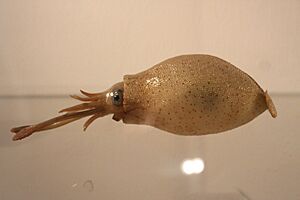Cranchia scabra facts for kids
The Cranchia scabra is a fascinating type of glass squid. It's the only species in its genus, and it's quite small, usually around 150 millimeters (about 6 inches) long. These squids live in the sunny, upper parts of the tropical Atlantic Ocean. Some squids in this group can even make their own light! Cranchia scabra was named after John Cranch, a naturalist who first described this amazing creature.
Contents
Amazing Squid Body Features
Bumpy Skin for Protection
This squid has a special skin, called a mantle, which is covered in large, bumpy structures. These bumps are made of cartilage, like the soft parts of your ears or nose. Scientists call these bumps "tubercles." They can be small and simple, or large and shaped like a complex cross. We think these bumps might help protect the squid from predators, but exactly how they work is still a bit of a mystery!
Special Water Chambers
Cranchia scabra has a unique way of controlling water inside its body. Its main body cavity is divided into different sections. This helps the squid manage water flow for breathing and moving. Water comes in through an opening near its head. It then moves through these special chambers. Water can leave through a small tube called a funnel. This clever system helps the squid live and move in the ocean.
Light-Up Organs
These squids have special light-producing organs called photophores. They are usually found around their eyes. These lights help them see in the dark parts of the ocean. The light can also scare away predators. Female squids even have photophores on the tips of their arms. These might be used to attract male squids when it's time to mate.
Quick facts for kids Cranchia scabra |
|
|---|---|
 |
|
| Conservation status | |
| Scientific classification | |
| Genus: |
Cranchia
|
| Species: |
scabra
|
| Synonyms | |
|
|
Where Glass Squids Live
Cranchia scabra squids are found all over the world. They live in the warm, open waters of tropical and subtropical oceans. Baby and young squids usually stay in the upper parts of the ocean, where sunlight can reach. As they grow bigger, adult squids move into deeper waters. They can live as deep as 2,000 meters (about 6,500 feet) below the surface!
How Glass Squids Behave
Moving Around in the Water
C. scabra squids are naturally "neutrally buoyant." This means they can float easily in the water without sinking or rising too much. They have a special fluid inside their bodies that helps them do this. They can change how they float and move by quickly flapping their fins.
When they need to escape quickly, they can pull their head and arms into their body. They also tuck their fins in tightly. This makes them form a tight, round ball. They can also release a cloud of ink inside their body. This makes the "ball" opaque, so predators can't see them. Scientists think this quick movement and inking is a way for them to escape danger.
What They Eat
C. scabra are predators. They are known to eat small fish. They also enjoy eating tiny crustaceans, which are like small shrimp or crabs. They will eat other small creatures that are about their size.
How They Find Mates
Glass squids are part of a group called Cephalopoda. In this group, there are separate male and female squids. When it's time to mate, male squids often perform special displays. These displays help them attract female squids. During mating, the male uses a special arm to transfer what's needed for fertilization into the female's body. The baby squids hatch as tiny, free-floating creatures. They then grow bigger to become adult squids.
How Glass Squids Grow
C. scabra are some of the fastest-growing squids! For the first 4 to 5 months, they eat a lot and grow very quickly. During this time, they stay in the upper, sunlit parts of the ocean. As they get older, they move into deeper waters. This is where they mature and have their own babies.
Scientists can figure out how old these squids are and how fast they grow. They do this by studying tiny, hard structures called statoliths. These are like little ear stones found in squids. They help the squid sense movement. By looking at the growth rings on these statoliths, scientists can learn a lot about the squid's life.



